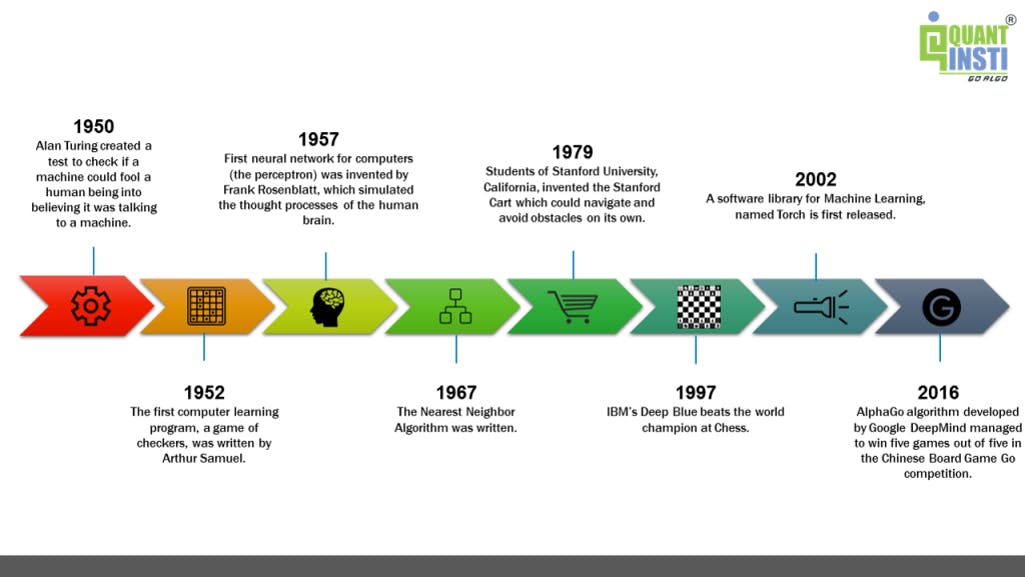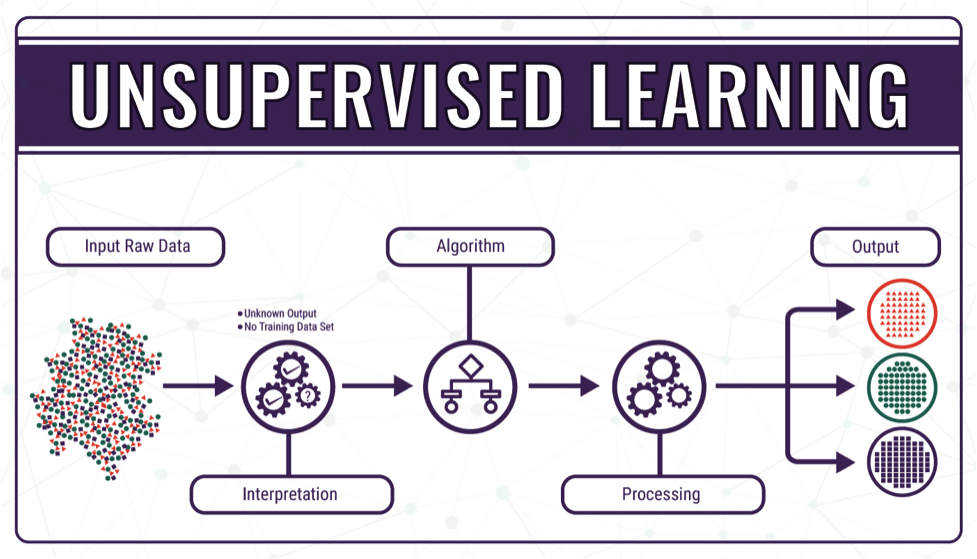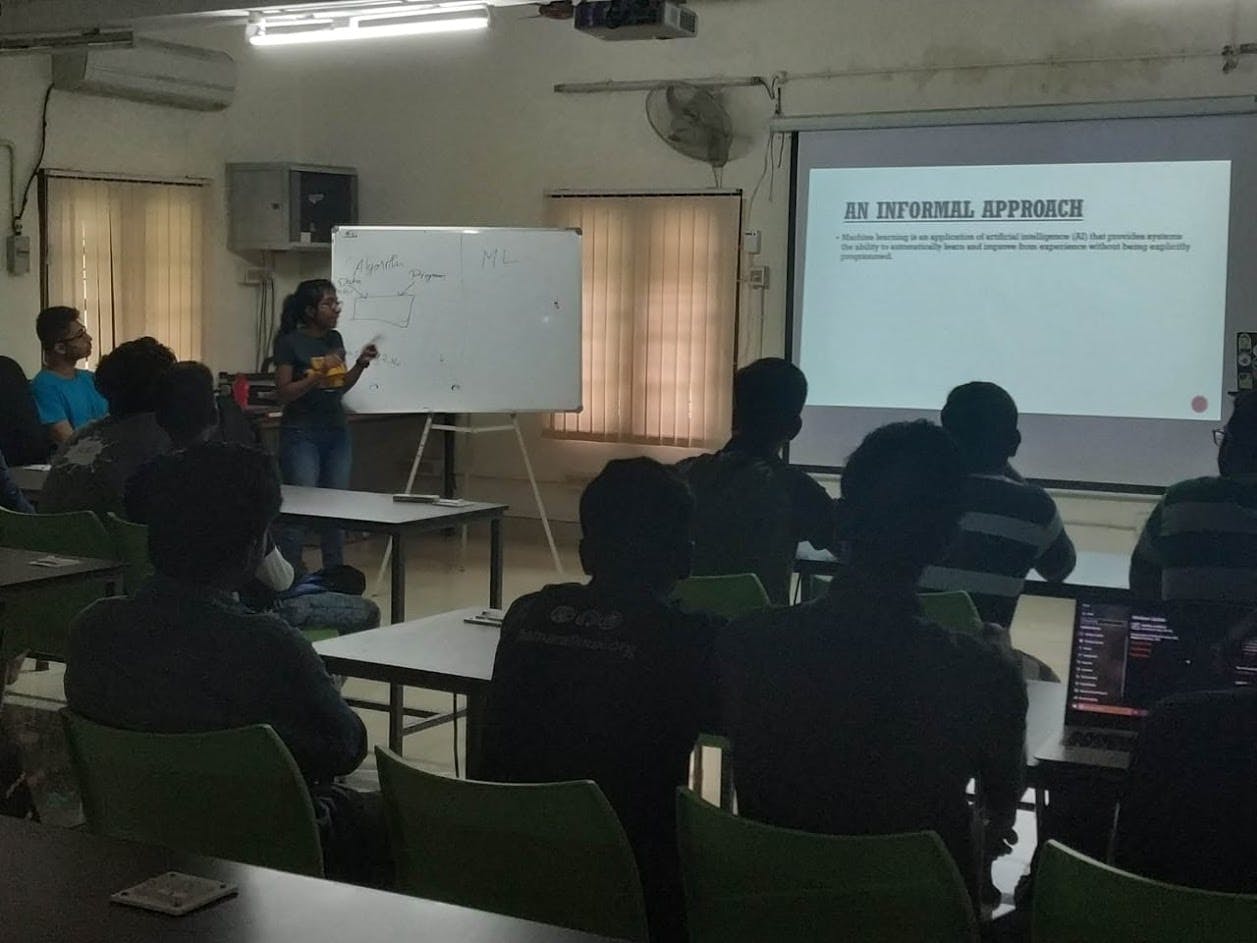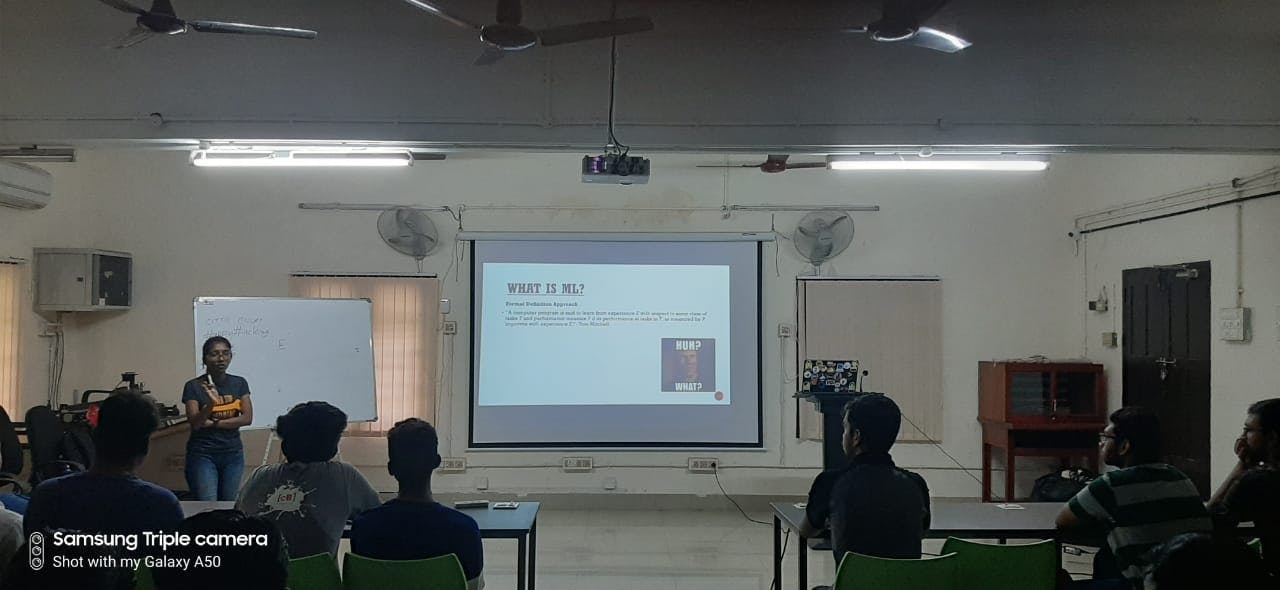
The class was conducted on 1st September, 2019. The Instructors for the program are Malavika Sreekumar , IT Final Year and Aravind Nair , IT Final Year.
Agenda
- What is Machine Learning?
- Difference between ML, AI and DL
- Timeline
- Day to Day Applications
- Types of Learning
- Resources
1. What is Machine Learning?
Formal Definition
“A computer program is said to learn from experience E with respect to some class of tasks T and performance measure P if its performance at tasks in T, as measured by P, improves with experience E.”- Tom Mitchell

Okay, okay! Let's try to understand what does this definition mean from this diagram.

We can use the above definition as a template and put E, T, and P at the top of columns in a table and list out complex problems with less ambiguity. It could be used as a design tool to help us think clearly about what data to collect (E), what decisions the software needs to make (T) and how we will evaluate its results (P).
Expecting that you have somewhat understood the definition given by Tom Mitchell, let's move on to a more simpler informal approach of this definition:
Machine learning is an application of artificial intelligence (AI) that provides systems the ability to automatically learn and improve from experience without being explicitly programmed.
2. Difference between ML, AI and DL
There are lot of people who use the terms Machine Learning (ML), Artificial Intelligence (AI) and Deep Learning (DL) interchangeably. Well I'm here to say that it's not same...ish!

As you can see on the above image of three concentric circles, DL is a subset of ML, which is also a subset of AI.
- What is Artificial intelligence?
It can be loosely interpreted to mean incorporating human intelligence to machines. Whenever a machine completes tasks based on a set of stipulated rules that solve problems (algorithms), such an “intelligent” behavior is what is called artificial intelligence.
- What is Machine learning?
It can be loosely interpreted to mean empowering computer systems with the ability to “learn”. The intention of ML is to enable machines to learn by themselves using the provided data and make accurate predictions. ML is a subset of artificial intelligence; in fact, it’s simply a technique for realizing AI. It is a method of training algorithms such that they can learn how to make decisions.
- What is Deep learning?
DL is the next evolution of machine learning. DL algorithms are roughly inspired by the information processing patterns found in the human brain. The brain usually tries to decipher the information it receives. It achieves this through labeling and assigning the items into various categories. Whenever we receive a new information, the brain tries to compare it to a known item before making sense of it — which is the same concept deep learning algorithms employ.
To read more about the differences between these 3 terms, here 's a beautiful article from where I tried to explain.
3. Timeline
Take a look into this picture and as you can see, this is not new!

4. Day to Day Applications
- Virtual Personal Assistants
Siri, Alexa, Google Now are some of the popular examples of virtual personal assistants. As the name suggests, they assist in finding information, when asked over voice. All you need to do is activate them and ask “What is my schedule for today?”
- Predictions while Commuting
When booking a cab, the app estimates the price of the ride. When sharing these services, how do they minimize the detours? The answer is machine learning.
- Social Media Services
People you may know: Facebook continuously notices the friends that you connect with, the profiles that you visit very often, your interests, workplace, or a group that you share with someone etc
Face Recognition: You upload a picture of you with a friend and Facebook instantly recognizes that friend. Facebook checks the poses and projections in the picture, notice the unique features, and then match them with the people in your friend list.
- Email Spam and Malware Filtering
There are a number of spam filtering approaches that email clients use. To ascertain that these spam filters are continuously updated, they are powered by machine learning. When rule-based spam filtering is done, it fails to track the latest tricks adopted by spammers.
- Product Recommendations
You shopped for a product online few days back and then you keep receiving emails for shopping suggestions. If not this, then you might have noticed that the shopping website or the app recommends you some items that somehow matches with your taste.
Fun Time!
If you're bored reading till here, why don't we play a game? No, not video games (-_-).

Here's an interesting game for you which uses deep learning to guess what you are drawing. Go to Quickdraw and try it!
5. Types of Learning
- Supervised Learning

Supervised learning as the name indicates the presence of a supervisor as a teacher. Basically supervised learning is a learning in which we teach or train the machine using data which is well labeled that means some data is already tagged with the correct answer. After that, the machine is provided with a new set of examples(data) so that supervised learning algorithm analyses the training data(set of training examples) and produces a correct outcome from labeled data.
In simple math, Supervised learning is where you have input variables (x) and an output variable (Y) and you use an algorithm to learn the mapping function from the input to the output.
Y = f(X)
The goal is to approximate the mapping function so well that when you have new input data (x) that you can predict the output variables (Y) for that data.
Supervised learning problems can be further grouped into regression and classification problems.
Classification: A classification problem is when the output variable is a category, such as “red” or “blue” or “disease” and “no disease”.
Regression: A regression problem is when the output variable is a real value, such as “dollars” or “weight”.
- Unsupervised Learning

Unsupervised learning is the training of machine using information that is neither classified nor labeled and allowing the algorithm to act on that information without guidance. Here the task of machine is to group unsorted information according to similarities, patterns and differences without any prior training of data. Unlike supervised learning, no teacher is provided that means no training will be given to the machine. Therefore machine is restricted to find the hidden structure in unlabeled data by our-self.
In simple math, unsupervised learning is where you only have input data (X) and no corresponding output variables.
The goal for unsupervised learning is to model the underlying structure or distribution in the data in order to learn more about the data.
Unsupervised learning problems can be further grouped into clustering and association problems.
Clustering: A clustering problem is where you want to discover the inherent groupings in the data, such as grouping customers by purchasing behavior.
Association: An association rule learning problem is where you want to discover rules that describe large portions of your data, such as people that buy X also tend to buy Y.
6. Resources
- Andrew Ng’s Machine Learning (Coursera)
- Sudheshna Sarkar’s Introduction to Machine Learning (NPTEL IIT Kgp)
- machinelearningmastery.com
- Towards Data Science (Medium Blog)
On personal note, in order to get some essence of Artificial Intelligence, start listening to MIT Artificial Intelligence Podcast. It won't teach you AI but it'll surely give a feel of it. There's no need to listen to this podcast with full concentration. Just put on your earphones and start hearing (I did not use the word listening deliberately) to it whenever you are bored.

This blog is written by Joel Johnson. Feel free to comment on this post if you have any queries and show us some love by liking the post!
Next post would be about Supervised and Unsupervised Learning in detail!
Hosted at CITTIC



